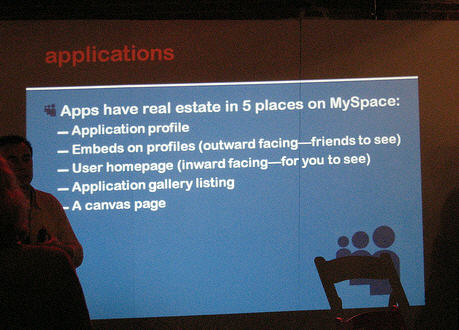Progress report on the OpenSocial Web

Google is releasing applications built on the Open Social API running on Orkut at the end of this month, and is holding "hackathons" February 7-8 and February 14-15 at Google's Mountain View, CA headquarters for OpenSocial developers.
In addition, MySpace unveiled its Developer Platform today, which uses the OpenSocial APIs to give developers the capability to run their applications on MySpace or any other "container" that supports OpenSocial. MySpace has added extensions that access friend lists and retrieve data available on public profiles if users grant permission to share the data.
At a launch party tonight at MySpace's new San Francisco offices, CTO Aber Whitcomb said that developers will have the next 30 days to test their apps in the a sandbox, before letting users get at the them. Whitcomb is soliciting feedback and potential changes in the APIs prior to the public-facing launch.
At the launch event Whitcomb outlined the five places where the applications live on MySpace (see below). Most interesting to developers is the canvas page, which allows developers to monetize applications with ads or other business models, as well as give users the capability to configure applications and access services.

In his blog Jeremiah Owyang, a senior analyst at Forrester, offered his take at this early stage of the MySpace development platform:
Expect a lot of trial and error development to occur, this is really and experimentation stage for the next 3 months. The platform will likely have a lot of tweaking and expect a lot of experimentation from the developer community. In the long run, MySpace will be able to successfully monetize, developers will profit, and brands will start to get involved. Hopefully, the user experience will respect the wishes of the users, and it will be a win for all.
In addition to progress in OpenSocial API and MySpace platform, Google recently introduced the Social Graph API. It allows information about the explicit public connections between people on the Internet, based on protocols such as XFN and FOAF, to be accessible to developers and users. For example, the Social Graph API will make it easier for users to find their social connections across sites.
However, some privacy concerns have surfaced. David Recordon of Six Apart has been at the center of the open social movement and expressed concerned about "ugly surprises when your relationships are available in a new or unexpected context." In his Six Apart blog he wrote:
I've had many conversations with Brad Fitzpatrick (who joined Google last August to develop this API) about the work we're trying to accomplish at both of our companies, as you can see from the initial publication of the "Thoughts on the Social Graph" last year. When I re-joined Six Apart last August I started developing an open source service that would crawl online relationship data and expose it via an API. I showed snippets of it on my blog (pictures and text), gave a brief demo at the Data Sharing Summit, and even came close to releasing an online tool which visualized all of your accounts and friends; instead we opted for demonstrating its power with a screencast showing how you could use it to find your friends. While this implementation of the API was based on publicly discoverable information (like Google's), we simply didn't feel comfortable shipping that project based on current implementations.
Why not? Well, for us to be comfortable that we weren't doing any evil, we wanted to make sure that we first had a way to clearly explain to non-technical users a few important points.
- Where each point of data about relationships is coming from
- How to hide or control sharing of data on each service you use
- A way to prompt the services to update relationships when they change, to make sure they're up to date, as we prototyped along with Ma.gnolia in October
The problem Recordon cites isn't exactly a privacy issue. The fact is data about relationships is on the public Web. Social network users can opt to hide their profiles and social graph from public Web search crawlers, but the default for the vast majority of users is to expose themselves on the public Web.
The Social Graph API is basic--it simply crawls for data about public connection. "MySpace data is not marked up in any way for the crawler," said David Glazer, director of engineering at Google. "It is public information."
Whitcomb suggested that one way give users and sites more control over what gets crawled and indexed is to modify the XFN specifcation and APIs so that there is a way to call out relationships that users don't want publicly exposed.
Glazer told me that a big part of any solution is increasing awareness among users about what it means to have public information on the Web. "It's right to have the dialog--the only way to have control over data is to know it's there. Tools will arise and people will invest in creating more high quality pages."
By high quality pages, he means users being more careful in managing their online presence as they did when the digital world was simpler and didn't have personal information embedded in a social graph. But until tools and protocols are available that give users a intuitive dashboard to manage their digital identities and networks, the "ugly surprises" Recordon fears will be an unpleasant exception for some segment of the Web population.
See also: ReadWriteWeb